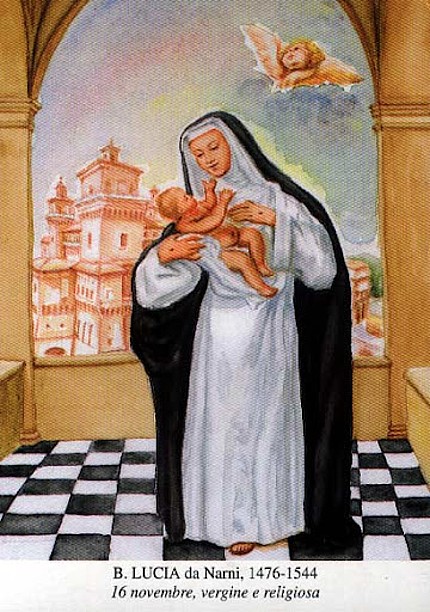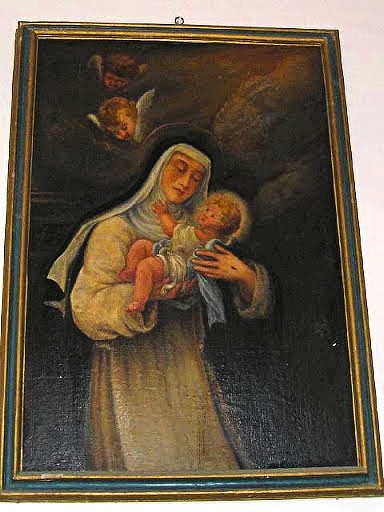Saint of the Day – 15 November – Blessed Lucia of Narni OP (1476-1544) Virgin, Tertiary of the Order of Preachers, Mystic, Stigmatist, Ecstatic, Married but remained chaste and fulfilled her vow of Virginity before she left her marital home and entered a Convent. Born on 13 December 1476 in Narni, Umbria, Italy as Lucia Brocadelli and died on 15 November 1544 at the Saint Catherine of Siena Convent in Ferrara, Italy of natural causes. Patronage – of Narni, Italy. Also known as – Lucy Brocadelli, Lucy de Alessio, Lucia Broccadelli. Her body is incorrupt.
Already very early it became evident to her pious Italian family that this child was set for something unusual in life. Lucia was born in 13 December 1476 on the feast day of Saint Lucia of Syracuse, the eldest of eleven children of Bartolomeo Brocadelli and Gentilina Cassio, in the Town of Narni (then called Narnia) and in the region of Umbria.
When Lucia was five years old, she had a vision of the Child Jesus with Our Lady. Two years later, Our Lady appeared with Child Jesus, Saint Catherine of Siena and Saint Dominic. Jesus gave her a ring and Saint Dominic gave her the scapular. At age 12, she made a private vow of total consecration, determined, even at this early age, to become a Dominican. However, family affairs were to make this difficult. During the following year Lucia’s father died, leaving her in the care of an uncle. And this uncle felt that the best way to dispose of a pretty niece was to marry her off, as soon as possible.
The efforts of her uncle to get Lucia successfully married form a colorful chapter in the life of the Blessed Lucia. Eventually the uncle approached the matter with more tact, arranging a marriage with Count Pietro of Milan, who was not a stranger to the family. Lucia was, in fact, very fond of him but she had resolved to live as a religious. The strain of the situation made her seriously ill. During her illness, Our Lady appeared to her again, accompanied by Saint Dominic and Saint Catherine and told her to go ahead with the marriage as a legal contract but to explain to Pietro that she was bound to her vow of virginity and must keep it. When Lucia recovered, the matter was explained to Pietro and in 1491 the marriage was solemnised.
Lucia’s life now became that of the mistress of a large and busy household. She took great care to instruct the servants in their religion and soon became known for her benefactions to the poor. Pietro, to do him justice, never seems to have objected when his young wife gave away clothes and food, nor when she performed great penances. He knew that she wore a hair-shirt under her rich clothing and that she spent most of the night in prayer and working for the poor.
But when, after having disappeared for the entire night, Countess Lucia returned home early in the morning in the company of two men and claimed that they were Saints Dominic and John the Baptist, Pietro’s patience finally gave out. He had his young wife locked up. Here she remained for the season of Lent; sympathetic servants brought her food until Easter. Being allowed to go to the Church, Lucia never returned. She went to her mother’s house and on the Feast of the Ascension, 1494, 8 May she put on the habit of a Dominican tertiary.
Count Pietro was furious, burned down the Dominican Priory and even tried to kill her spiritual director who had given her the habit. Rich and influential, he continued to try to bring her back. The following year, Lucia went to Rome and entered the Monastery of the Dominican tertiaries near Pantheon. Her sanctity impressed everyone so much that by the end of the year, with five other Sisters, she was sent by the Master General of the Dominicans, to start a new Monastery in Viterbo.
On Friday, 25 February 1496, Lucia received the Stigmata, the Sacred Wounds. She tried very hard to hide her spiritual favours because they complicated her life wherever she went. She had the stigmata visibly and she was usually in ecstasy, which meant a steady stream of curious people who wanted to question her, investigate her, or just stare at her. Even the Sisters were nervous about her methods of prayer. Once they called in the Bishop, and he watched Lucia with the sisters for 12 hours, while she went through the drama of the Passion.
The Bishop hesitated to pass judgement and called for special commissions; the second one was presided by a famous Inquisitor of Bologna. All declared that her Stigmata were authentic. Here the hard-pressed Pietro had his final appearance in Lucia’s life. He made a last effort to persuade hery to come back to him. After seeing her, he returned to Narni, sold everything he had and became a Franciscan. In later years, he was a famous preacher.
The Duke of Ferrara was planning to build a Monastery and, hearing of the fame of the mystic of Viterbo, asked Sister Lucia to be its Prioress. Lucia had been praying for some time that a means would be found to build a new Convent of strict observance and she agreed to go to Ferrara. This led to a two-year battle between the Towns. Viterbo had the Mystic and did not want to lose her; the Duke of Ferrara sent first his messengers and then his troops to bring her. Much money and time was lost before she finally escaped from Viterbo and was solemnly received in Ferrara on 7 May 1499.
Various problems arose in the Convent due to the Duke bringing all sorts of unsuitable people to view ‘his’ Convent and Stigmatist. the Sisters petitioned the Bishop and, by the order of the Pope, he sent ten nuns from the Second Order to reform the community. Lucia’s foundation was of the Third Order; of women who remained part of the laity even after their vows. The Second Order “real” nuns, according to the chronicle, “brought in the very folds of their veils the seed of war.” Nnuns of the Second Order wore black veils, a privilege not allowed to tertiaries.
The uneasy episode ended when one of these ten nuns was made Prioress and when the Duke died on 24 January 1505. Lucia was placed on penance. The nature of her fault is not mentioned, nor was there any explanation of the fact that, until her death, 39 years later, she was never allowed to speak to anyone but her Confessor, who was chosen by the Prioress. Only now, 500 years later, the situation is slowly beginning to clear.
The Dominican Provincial, probably nervous for the prestige of the Order, would not let any member of the Order go to see her. Her Stigmata disappeared, too late to do her any good and vindictive companions said: “See, she was a fraud all the time.” When she died in 1544, people thought she had been dead for many years. It is hard to understand how anyone, not a saint, could have so long endured such a life. Lucia’s only friends during her 39 years of exile were heavenly ones – the Dominican Catherine of Racconigi, sometimes visited her – evidently by bi-location – and her other heavenly friends often also came to brighten her lonely cell.
Immediately after her death everything suddenly changed. When her body was laid out for burial so many people wanted to pay their last respects that her funeral had to be delayed by three days. Her Tomb in the Monastery Church was opened four years later and her perfectly preserved body was transferred to a glass case. When Napoleon suppressed her Monastery in 1797, her body was transferred to the Cathedral of Ferrara and on 26 May 1935 to the Cathedral of Narni.
So many miracles occurred at her Shrine that Lucia was finally Beatified on 1 March 1710 by Pope Clement XI.
It is thought that Lucia was the inspiration for th little girl Lucy, who could see many things that no-one else could, in C S Lewis’ The Chronicles of Narnia.








One thought on “Saint of the Day – 15 November – Blessed Lucia of Narni OP (1476-1544)”